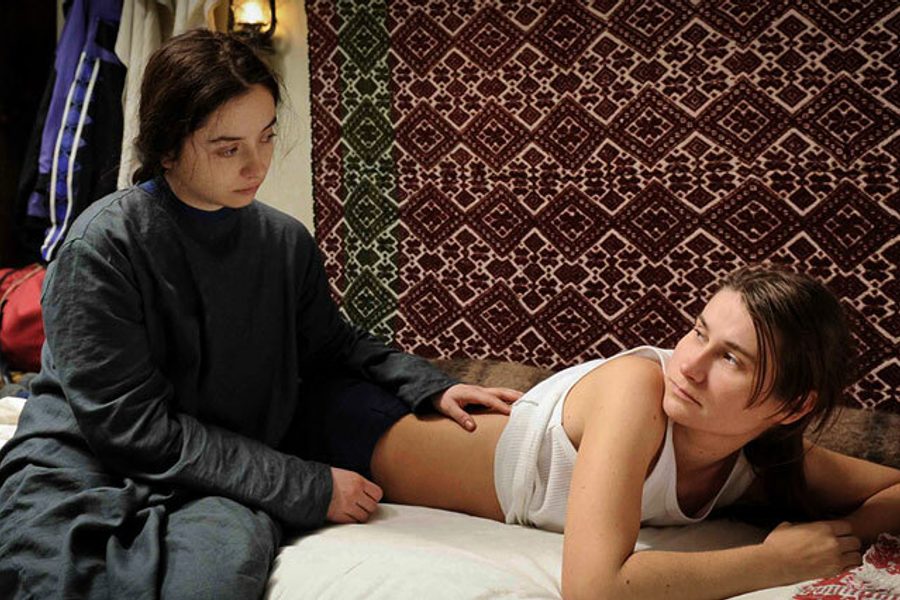A Romanian Exorcism
Cristian Mungiu’s film ‘Beyond the Hills’ will take your breath away.
Michael Atkinson

Cristian Mungiu’s film Beyond the Hills is the best Romanian film ever imported to American screens and that’s saying a good deal. For eight years, the Romanian new wave has provided the only dependable action in the 21st-century art house, fueled by the gravitas that comes with generations of brutal Communist dictatorship, the reverb of its violent overthrow and the deathless ancestral textures of Balkan peninsula peasant culture. The Death of Mr. Lazarescu (2005), 4 Months, 3 Weeks and 2 Days (2007) and Aurora (2011) all limn a horrific and grim view of life either within the Ceausescu regime or in its struggling aftermath. But Beyond the Hills is a ferociously original step to the left, and its thematic arsenal is universal and penetrating.
The Romanians’ hypernaturalism is in play in the film — the first shot, tracking hurriedly behind a girl searching for someone between stopped trains, is a classic in medias res move straight from the Dardenne brothers. But Mungiu is not interested in texture or mood for its own sake, and his movie is visually very simple. All of its chips are saved for the story — a tale semi-fictionalized in novels by Romanian journalist Tatiana Niculescu Bran. The girl, Voichita (Cosmina Stratan), is meeting her lifelong friend Alina (Cristina Flutur) at the station; when they clinch, Alina begins sobbing. Voichita, we learn, is a nun in an ascetic convent in the Transylvanian outlands, and as they return there, with Alina as a square-peg visitor to the strict Orthodox enclave, the girls’ backstory gradually comes to light.
While the girls grew up in a nearby orphanage, they were not just abused comrades but lovers, and now Alina, raw from her lonely life as an immigrant in Germany, has come back for Voichita. But the devout Voichita has found a sanctuary whose equilibrium will be destroyed if the girls’ true relationship is divulged, which seems increasingly inevitable, as Alina grows unstable and violent, passionately trying to find some way to be with Voichita. The scenario builds like a horrifying bolero, until the convent denizens are led to the ultimate recourse — exorcism.
Mungiu has a master’s grip on what’s at stake — the chaotic, bloody dogfight between the past and the present, but with a difference: the convent, instituted fairly recently by its patriarchal priest and carved out of dead farmland, is itself a reaction to the madness and banality of modern life in Romania. The priest and the nuns are not absurd fanatics. The film scrupulously respects their faith, and their desire for peace and separation. The nuns are obviously seasoned women, beaten by modernity and retreating into a sacred space in their own heads. Alina, too, is a perfectly coherent character, touched with post-teen l’amour fou but also strung out from a hardscrabble life of rotten jobs and, possibly, sex work in Eastern Europe. She’s at the end of her slender rope, and yet the refuge Voichita has found in this muddy no-man’s-land does not suit her. In fact, her confrontation with this tenuous fringe world becomes a life-or-death struggle.
At the same time, Mungiu’s iconic images take your breath away — beginning with a scene in which the nuns take a writhing Alina to the local hospital bound in bell rope, like a medieval heretic. Then there’s the crucifixion. It’s indicative of the film’s dramatic craft that such galvanic moments are arrived at with inexorable logic and without strained melodramatics or subplots.
For cinephiles, the ghost continually evoked is Carl Dreyer, whose The Passion of Joan of Arc (1928) and Ordet (1955) are 20th-century film’s definitive considerations of orthodox faith in combat with life on earth, and vice versa. The gravity with which Dreyer treated this struggle saturates Mungiu’s film, however much the styles differ. Mungiu’s ultra-realist boots are on the ground, whereas Dreyer’s universe was ethereal and artificially stripped of clutter. The acting is almost documentary-genuine, and in its own way just as bullshit-free as Dreyer’s.
No other film depicts extreme religious experience with such even-handedness even as it uses a relic paradigm from a bygone eon as an arena for the troubles of the lost children of post-Communist Europe. It’s early yet, but Mungiu’s tough film might be 2013‘s most essential release.

I hope you found this article important. Before you leave, I want to ask you to consider supporting our work with a donation. In These Times needs readers like you to help sustain our mission. We don’t depend on—or want—corporate advertising or deep-pocketed billionaires to fund our journalism. We’re supported by you, the reader, so we can focus on covering the issues that matter most to the progressive movement without fear or compromise.
Our work isn’t hidden behind a paywall because of people like you who support our journalism. We want to keep it that way. If you value the work we do and the movements we cover, please consider donating to In These Times.








